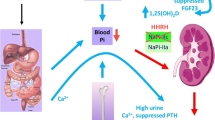Abstract
Vitamin D deficiency rickets occasionally resembles pseudohypoparathyroidism type II (PHP type II) with respect to the response to exogenous PTH in the presence of hypocalcemia. We encountered a Japanese patient with stage 2 vitamin D deficiency rickets, who had increased urinary cAMP excretion and no response of urinary phosphate or N-acetyl-β-D-glucosaminidase excretion to exogenous PTH under normocalcemic and normophosphatemic conditions, after treatment with 1,25(OH)2 vitamin D3. This case shows that it is possible for a response mimicking that of PHP type II to occur when the serum calcidiol level is low due to causes other than hypocalcemia and secondary hyperparathyroidism. When the serum calcidiol level is low, the appropriate treatment should be cholecalciferol or ergocalciferol. However, because neither is commercially available as a useful formulation in Japan, physicians are forced to inappropriately use calcitriol or analogs.
Similar content being viewed by others
References
Srivastava T, Alon US. Stage I vitamin D-deficiency rickets mimicking pseudohypoparathyroidism type II. Clin Pediatr (Phila) 2002, 41: 263–8.
Fraser D, Kooh SW, Scriver CR. Hyperparathyroidism as the cause of hyperaminoaciduria and phosphaturia in human vitamin D deficiency. Pediatr Res 1967, 1: 425–35.
Kruse K, Kracht U. Parathyroid function in different stages of vitamin D deficiency rickets. Eur J Pediatr 1984, 141: 158–62.
Dandona P, Mohiuddin J, Jeremy J, Weerakoon J. Hyperphosphataemic rickets: a new variant. BMJ 1983, 287: 1765.
Rao D, Parfitt AM, Kleerekoper M, Pumo BS, Frame B. Dissociation between the effects of endogenous parathyroid hormone on adenosine 3′,5′-monophosphate generation and phosphate reabsorption in hypocalcemia due to vitamin D depletion: An acquired disorder resembling pseudohypoparathyroidism Type II. J Clin Endocrinol Metab 1985, 61: 285–90.
Lewin IG, Papapoulos SE, Hendy GN, Tomlinson S, O’riordan JLK. Reversible resistance to the renal action of parathyroid hormone in human vitamin D deficiency. Clin Sci (Lond) 1982, 62: 381–7.
Rasmussen H, Deluca HF, Arnaud C, Hawker C, von Stedingk M. The relationship between vitaminD and parathyroid hormone. J Clin Invest 1963, 42: 1940.
Forte LR, Nikols GA, Anast CS. Renal adenylate cyclase and the inter-ralationship between parathyroid hormone and vitamin D in the regulation of urinaly phosphate and adenosime 3′,5′-cyclic monophosphate excreton. J Clin Invest 1976, 57: 559–68.
Carnes DL, Anast CS, Forte LR. Impaired renal adenylate cyclase response to parathyroid hormone in the calcium deficient rat. Endocrinology 1978, 102: 45–51.
Mizunashi K, Taguchi K, Kuwahaa M, Miura R, Yumita S, Yoshinaga K. Effects of parathyroid hormone on urinary excretion of N-acetyl-b-D-glucosaminidase in idiopathic hypoparathyroidism and pseudohypoparathyroidism. Calcif Tissue Int 1989, 45: 375–7.
Iwata T, Uchida S, Hori M, Sakai K, Towatari T, Kido H. Human parathyroid hormone (1-34) increases urinary excretion of lysosomal enzymes in rats. Life Sci 1999, 65: 1725–32.
Hillman LS. Mineral and vitamin D adequacy in infants fed human milk or formula between 6 and 12 months of age. J Pediatr 1990, 117: S134–42.
Mughal MZ, Salama H, Greenaway T, Laing I, Mawer EB. Lesson of the week Florid rickets associated with prolonged breast feeding without vitamin D supplementation. BMJ 1999, 318: 39–40.
Ahmed I, Atiq M, Iqbal J, Khurshid M, Whittaker P. Vitamin D deficiency rickets in breast-fed infants presenting with hypocalcaemic seizures. Acta Paediatr 1995, 84: 941–2.
Vieth R. Why “Vitamin D” is not a hormone, and not a synonym for 1,25-dihydroxy-vitamin D, its analogs or deltanoids. J Steroid Biochem Mol Biol 2004, 89-90: 571–3.
Chase LR, Melson GL, Aurbach GD. Pseudohypoparathyroidism: defective excretion of 3′,5′-AMP in response to parathyroid hormone. J Clin Invest 1969, 48: 1832–44.
Author information
Authors and Affiliations
Corresponding author
Rights and permissions
About this article
Cite this article
Inamo, Y. Limited availability of nutritional vitamin D causing inappropriate treatment of vitamin D deficiency rickets with a response resembling pseudohypoparathyroidism Type II in a Japanese patient. J Endocrinol Invest 28, 834–837 (2005). https://doi.org/10.1007/BF03347577
Accepted:
Published:
Issue Date:
DOI: https://doi.org/10.1007/BF03347577




